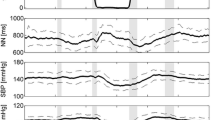Abstract
The purpose of this work was to determine the dynamics of changes in the state of the human cardiovascular system at rest and upon exposure to lower body negative pressure (LBNP) in different periods of short-term (8–25 days) and long-term (126–438 days) space flights (SFs) using the data of ultrasonic examinations and leg occlusive plethysmography. It was established that the changes caused by blood redistribution and hypovolemia development—a decreased left-ventricular filling and stroke volume without an impairment of myocardial contractility, a decreased renal artery resistance, and an increased maximal capacity of leg veins—occurred in the first week of an SF. Over 30–40 days of SF, these changes increased and were followed by the relative stabilization of hemodynamics at rest. Arterial cerebral blood flow was stable; however, the phenomena of venous congestion in this region increased with the SF’s duration. The most dramatic changes were observed in leg vessels, both in arteries (decreased resistance) and veins (increase in maximum capacity). Changes in the venous part of the cardiovascular system were more marked than in the arterial one. Despite the relative stabilization of the hemodynamics at rest, exposure to LBNP revealed a deterioration of gravity-dependent reactions, which changed as a function of the SF duration. In the first month of FS, the downward trend of the femoral artery vasoconstriction was not detrimental to cerebral blood flow. SF extension impaired the regulation of the vascular tone and caused increased blood flow deficiency on exposure to LBNP. In some cases, the hemodynamic response was affected to the extent that could be regarded as a failure to adapt to orthostatic effects.
Similar content being viewed by others
References
Fomina, G.A., Kotovskaya, A.R., Polyakov, V.V., et al., Influence of Weightlessness on Human Central and Peripheral Hemodynamics According to the Data of Ultrasound Methods of Examination, Orbital’naya stantsiya “Mir” (Mir Orbital Station), 2002, vol. 2,ch. 8, p. 529.
Fomina, G.A., Arbeille, Ph., Kotovskaya, A.R., et al., Detection of the Early Signs of Human Orthostatic Instability by Peripheral Blood Flow Response to LBNP, Orbital’naya stantsiya “Mir” (Mir Orbital Station), 2002, vol. 2,ch. 8, p. 520.
Fomina, G.A. and Kotovskaya, A.R., Changes in Human Venous Hemodynamics in Long-Term Space Flights, Aviakosm. Ekol. Med., 2005, vol. 39, no. 4, p. 25.
Fomina, G.A., Kotovskaya, A.R., Pochuev, V.I., and Zhernavkov, A.F., Changes in the Hemodynamic Mechanisms Affording Orthostatic Stability of Humans in Long-Term Space Flights, Aviakosm. Ekol. Med., 2005, vol. 39, no. 6, p. 9.
Fomina, G.A. and Kotovskaya, A.R., Hemodynamic Changes under Long-Term Weightlessness Conditions and the Importance of Hypovelemia, Aviakosm. Ekol. Med., 2008, vol. 42, no. 2, p. 21.
Shik, L.L. Sergeeva, K.A., and Moiseev, V.A., Study of the Causes of Orthostatic Instability, in Problemy kosmicheskoi biologii (Problems of Space Biology), 1975, vol. 31, p. 157.
Arbeille, Ph., Fomina, G., Pottier, J.M., et al., Heart and Peripheral Arteries and Veins during the 14 Month MIR Space Flight, J. Gravit. Physiol., 1996, vol. 3, p. 95.
Martin, D.S., South, D.A., Wood, M.L., et al., Comparison of Electrocardiographic Changes after Short- and Long-Duration Space Flight, Aviat. Space Environ. Med., 2002, vol. 73, no. 6, p. 532.
Perhonen, M.A., Franco, F., Lane, L.D., et al., Cardiac Atrophy after Bed Rest and Space Flight, J. Appl. Physiol., 2001, vol. 91, p. 645.
Tobal, N., Roumy, J., Herault, S., et al., Cardiac, Cerebral and Lower Limb Hemodynamic Changes, during HDT (5 to 42 Days) and Space Flights (7 Days to 6 Months), J. Gravit. Physiol., 2001, vol. 8, no. 1, p. 53.
Author information
Authors and Affiliations
Additional information
Original Russian Text © G.A. Fomina, A.R. Kotovskaya, E.V. Temnova, 2010, published in Aviakosmicheskaya i Ekologicheskaya Meditsina, 2009, Vol. 43, No. 3, pp. 11–16.
Rights and permissions
About this article
Cite this article
Fomina, G.A., Kotovskaya, A.R. & Temnova, E.V. Dynamics of human cardiovascular responses in different periods of long-term exposure to weightlessness. Hum Physiol 38, 715–720 (2012). https://doi.org/10.1134/S0362119712070080
Received:
Published:
Issue Date:
DOI: https://doi.org/10.1134/S0362119712070080




